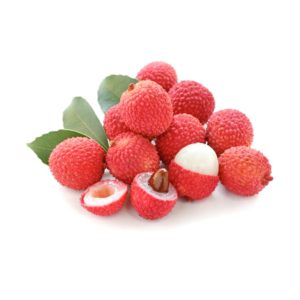
Sometimes known as “litchi” or a similar spelling variation, lychee fruit is from the soapberry family. The evergreen trees they grow on can reach 100 feet, and produce red or pale orange fruits with a tough, “bumpy,” easily peeled skin resembling large raspberries. Each contains white flesh and a single, large, inedible seed, which makes this fruit a drupe. Lychee is juicy with a distinctive, slightly acidic fragrance and flavor, comparable to grapes.
With the first mention found in Chinese literature circa 1059 A.D., ensuing centuries took lychee production from Burma in the 1600s to India a century later, the West Indies in 1775, and to French and English greenhouses by the 19th century. Because it does best in warm, humid climates, lychee thrived in Hawaii, Florida, and then California in the latter years of the 1800s. Lychees are an international fruit now, from Australia to Brazil, Burma to Africa.
Lychee fruit is high in the antioxidant Vitamin C and the essential mineral Potassium.
Preparation
Peel the skin and eat the white flesh around the seed.
Lychees keep well, offering perhaps better-than-fresh quality after a few weeks of storage. They turn brown, which sometimes indicates increased sweetness.
Dried lychees are larger but similar to raisins, and a prized delicacy in some countries. Sealed well, they can be stored for as long as a year. Fresh or dried, lychees can be chopped into fruit or green salads. Stuffed lychees are popular with cream cheese and nuts.